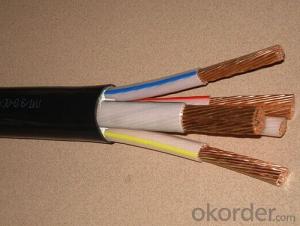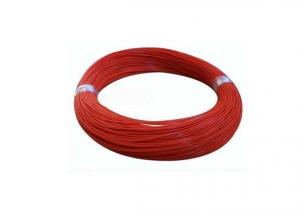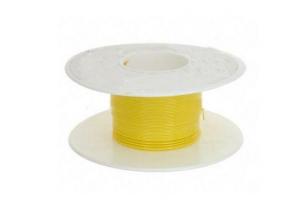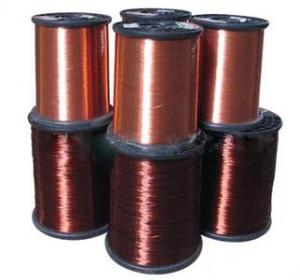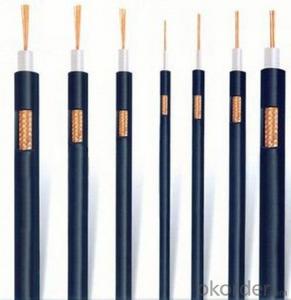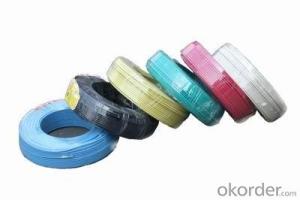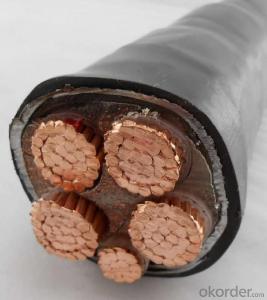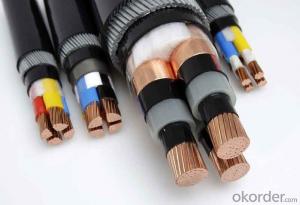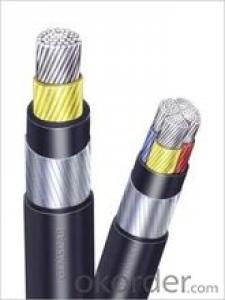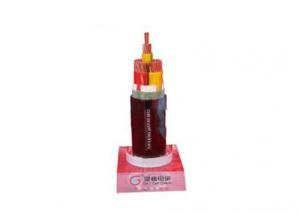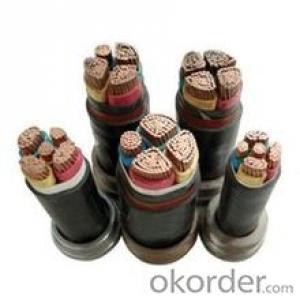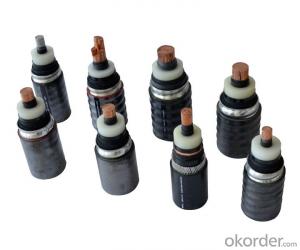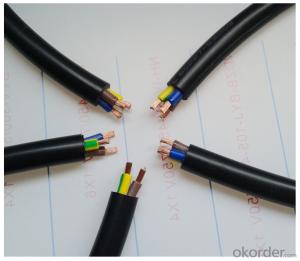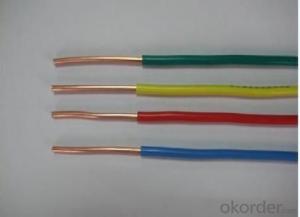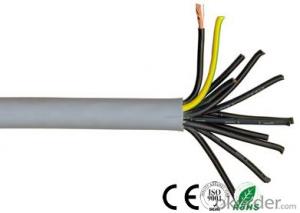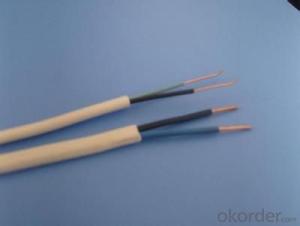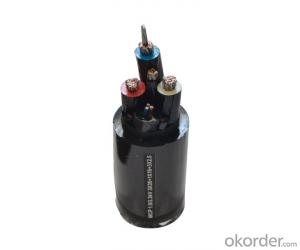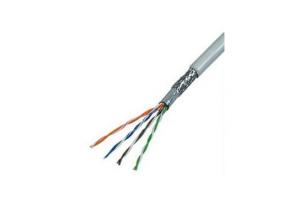XLPE Insulated Power Cable/0.6/1KV Cu/Al Conductor
- Loading Port:
- China main port
- Payment Terms:
- TT OR LC
- Min Order Qty:
- 500 m
- Supply Capability:
- 50000 m/month
OKorder Service Pledge
OKorder Financial Service
You Might Also Like
1 Information
a, Number of cores:
1, 2, 3, 3+1, 3+2, 3+3, 4, 4+1, 4+2, 5 and so on.
b, Construction:
Conductor: Solid or stranded copper Insulation: Cross-linked polyethylene (XLPE) or Polyvinyl chloride (PVC) Filler: Polypropylene filament with lapped binding tape Binder: Binding tape Inner sheath: Polyvinyl chloride (PVC) Amour: Galvanized steel wire armored(SWA) or steel tape armored(STA) Sheath: Polyvinyl chloride (PVC)
c, Nominal Section Area(mm2) :1.5 2.5 4 6 10 16 25 35 50 70 95 120 150 185 240 300 400 500 630 800
d, Features
XLPE insulated power cable do not has excellent electric, mechanical properties,but also has powerful resistance against chemical corrosion,heat resistance and enviromental stress resistance. Its structure is simple. The long period operating temperature is +90 °C. It is conveninet to use and can be laid with no restriction of different level.
XLPE insulated steel wire armoured power cable: XLPE/PVC insulated power cable has a number of advantages over paper insulated and PVC insulated cable. XLPE cable has high electric strength, mechanical strength, high-ageing resisting, environmetal stress resisting antichemical corrossion, and it is simple construction, using convenient and higher operating of long term temperature. It can be laid with no drop restriction.
Various of flame-retardant and non-flame retardant XLPE cable can be manufactured with three technology(peroxide, silane and irradiation crosslinking). The flame-retardant cable covers all kinds of low-smoke low-halogen low-smoke halogen free, and non-smoke nonhalogented and three classes of A, B, C.
2 Standard:
IEC60502,and BS6346, VDE, AS/NZS, UL,etc or as customer's request.
3 The Rated Voltage(kv):
1st class 0.6/1 1.8/3 3.6/6 6/10 8.7/15 12/20 18/30 21/35 2nd class 1/1 3/3 6/6 8.7/10 12/15 18/20 - 26/35
4 Application:
1)These cables are most suitable for direct burial or for installation on trays or ducts, Where there is a risk of mechanical damage, armoured cables should be used.
2) For laying in ground along route with large difference of level able to bear external mechanical forces.
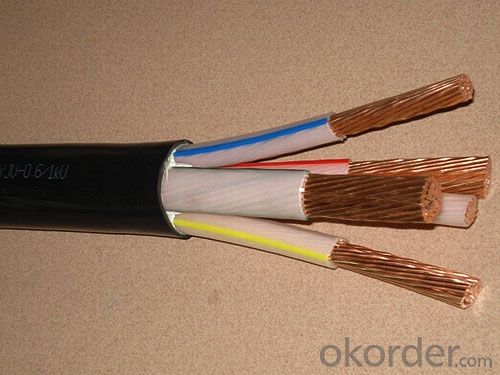
- Q: I have tried hot sauce. I have to cover all my wires with car wire covers.
- i have had the same problem with norwegian forest cats crosses and my seven week old kittens are doing it now. i have wrapped them in tin foil at the moment it is working. my sister used bitter apples on her wires which also worked.
- Q: i have a 1981 honda express (nc50)and i'm trying to read the wiring diagram
- The circuit you have given is for the ignition. The symbol is for an SCR (silicon controlled rectifier). Triggering the SCR with the coil in the flywheel causes the SCR to discharge the capacitor through the ignition coil. Once discharged the capacitor (also called a condenser) discharges below the sustaining current of the SCR and commutates (ceases conducting) ready for the next charging pulse.
- Q: Just bought the wire only one month to see the inside of the copper wire does not pull a few, and would like to know why is this ah, this dare dare to use the wire, experts please answer! More
- (AX-310HHC) cooler cool cool supreme falcon hard drive is now no price or price soaring to buy or To find a friend not used second-hand hard drive if it is a parallel port to buy a adapter card to buy a 50 or so into the best is to spend a 50-60 block to accept a second-hand brand machine chassis down also estimated that 1100-1200 this configuration The purpose is very simple, that is, so you can in the case of cheap as possible to meet a daily life office needs of the machine, and the quality of the parts and not too far behind. Inte the G530 quite some to occupy the low-end market means, first of all its performance than the previous generation of low-end goods E5000 and Athlon 200 series to a little bit, and its power consumption is very low, with Athlon Than the chicken is the gap between wow, which makes his power and heat control is to force, do not need a good radiator. And G530 comes with a nuclear show, the effect does not say how good, the most basic 3D games, such as Warcraft CS play a play or no pressure, but also support the hard solution, see the film also solved the problem. The price is also particularly cheap, less than . almost can be said that the low-end first choice.
- Q: The total power of six kilowatts need to install the number of square wires
- See you specifically what electrical appliances to take what is, 1 ? BV line can be connected to 3 kilowatts, but have to take into account the voltage and start the current, please add detailed friends ~
- Q: HelloRecently I installed 100W Bulbs in my home and noticed that the light fixtures became extremely hot and within 10 minutes they had started melting the insulation. So i looked at the wire and found that it was 18 Gauge and found that through all fixtures of the home some of them with at least 20 feet of wiring is this up to code? I also noticed that many sockets would not allow a laptop to charge or even a cell phone what could be the cause of this? I'm in ontario canada.
- On the fixture it self under the cover should be a sticker listing the max wattage of a bulb to use if its says say 60w max then you put a 100w in you answered your own question. Light fixtures are rated for wattage put to much in end result is over heated wires melted fixture and or a fire Buy a new one rated for a 100w most folks don't know they are rated hope that helps Lr
- Q: cf ceiling fanlf old light fixtureI took down the old light fixture and there are 4 wires total; 2 white wires. Then there is 2 black taped off wires. The 2 white wires were the only wires connected, separately to the old light fixture. I tested all of the wires and all are hot except 1 white wire. I assumed that was ground. I installed my ceiling fan as follows; cf white wire to lf white wire. cf ground wire to non-hot lf white wire. cf black and black/white wire to only 1 lf black wire. I taped off the other hot black wire because i didn't think i needed to connect it. Turned light switch on, nothing. Fan does not work, light in fan does not work. Did I connect the wires incorrectly----- HELP! Thanks!
- You didn't say if you had a wall switch. This matters. Generally, both white wires are spliced together and these are the neutral. The 2 black wires are both hot. The ground wires are green or bare copper. You should have 2 black wires coming out of the light/fan; these are hot and are spliced to 2 hot wires from the ceiling fixture. Always black to black and cap these off. You hooked up the white neutral wire to the ground wire which is incorrect. If you don't have a ground wire coming out from the ceiling fixture which would be green or bare copper, just hook the ground wire from the light/fan to the metal plate in the ceiling. Good Luck!
- Q: I had a space heater on in a bedroom. I know, dumb idea, but it was plugged in to a power strip, which was plugged into a standard outlet. It was on for about 30 minutes. Then, it just shut off. I thought nothing of it, but when i unplugged the heater and later tried to plug other things into the power strip, the light on the power strip was on (the one that is always on if the strip is getting power), but nothing plugged in would work, even after resetting it. My house s circuit breaker did not trip. After unplugging the power strip, the outlet still works if I plug somethig in. This is probably insanely paranoid of me, but could this cause damage to my home s electrical wiring? Could this cause an electrical fire after everything has been unplugged?Thank you.
- Yes space heaters can. it isn't common but may be possible. Surge protectors aren't extention cords they are a device to protect electronic devices from an electrical over charge or surge. So under high wattage use will fry the electrical connections in the protector. That's probably what happened here. Other times they can catch fire and maybe a small explosion. The largest electric space heaters are around 1500w and draw about 12 amps. Most home outlets are rated at 15A or even 20A. So in good working order most heaters won't hurt an outlet or wiring if that is the only thing on that breaker. If things do go higher the breaker should trip and cut power. If the breaker is old or damaged it may not trip and then somethings gotta give next either the outlet or the wiring normally it's the plug but if two things on two plugs the wire may catch fire. also don't use cheap extention cords they will catch fire you can use extention cords but rated at least 14G for 15A or 12G for 20A.
- Q: I am installing electrical wiring to an 8x12 portable building. I would like to have about five 110 outlets. One outlet will run a 5,000 btu ac. The other will run a small refrigerator. Can I run all this will a single 110 breaker?
- I recommend that you run 10/3 to the shed. Install a small sub panel and use 20 amp circuits to dedicate for the a/c and the fridge, and perhaps one more for each of the additional outlets so they can adequately handle any power equipment you might use. You would feed this with a 2 pole 30 amp breaker in your main panel. Keep grounds and neutrals separate in the sub panel. If you don't want to go this route, then run a 12/3 wire from a 2 pole 20 amp breaker and put the a/c and fridge together on one leg, and use the other leg to feed your other outlets. Other option there is to use 2 lengths of 12/2 and 2 single pole 20 amp breakers. Having the 30 amp sub panel will guarantee your future needs. 20 amp circuits will guarantee you no lag and no tripping of circuits if you ever use a space heater, an air compressor and saw at the same time, etc. 15 amp circuits will make it a stretch to put the fridge and a/c together on one circuit and generally don't handle power tools/equipment well.
- Q: i installed a new overhead light, but the closest power source is a run of wire between two receptacles. could i splice into this wire or is there a way to come out of one receptacle, into the light switch, then back out of the switch into another receptacle? thanks
- Sure, it is technically possible. But not while legally obeying wiring regulations the lighting and power should be on separate circuits suppose that - a few years down the line - someone tried to do something with that light fitting, and went and turned off the lighting circuit to avoid electrocuting themselves. but not the power circuit. I am sure you can imagine the results [edit - 4 thumbs down, gawd.there are some real cowboys out there]
- Q: I have a lot of equipment in my local and I'm suffering about big cargo in electric wire for your knowledge voltage 220 Ventensity 30 Awire Demetre 2.5 mmwhat should I do for avoid the damaging of disgenctor or burning of wire
- The wires too small for 30A! You need to upgrade the wire size or lower the amperage! The set-up you now have is just begging for a fire! Be Careful! ;-)
Send your message to us
XLPE Insulated Power Cable/0.6/1KV Cu/Al Conductor
- Loading Port:
- China main port
- Payment Terms:
- TT OR LC
- Min Order Qty:
- 500 m
- Supply Capability:
- 50000 m/month
OKorder Service Pledge
OKorder Financial Service
Similar products
Hot products
Hot Searches
